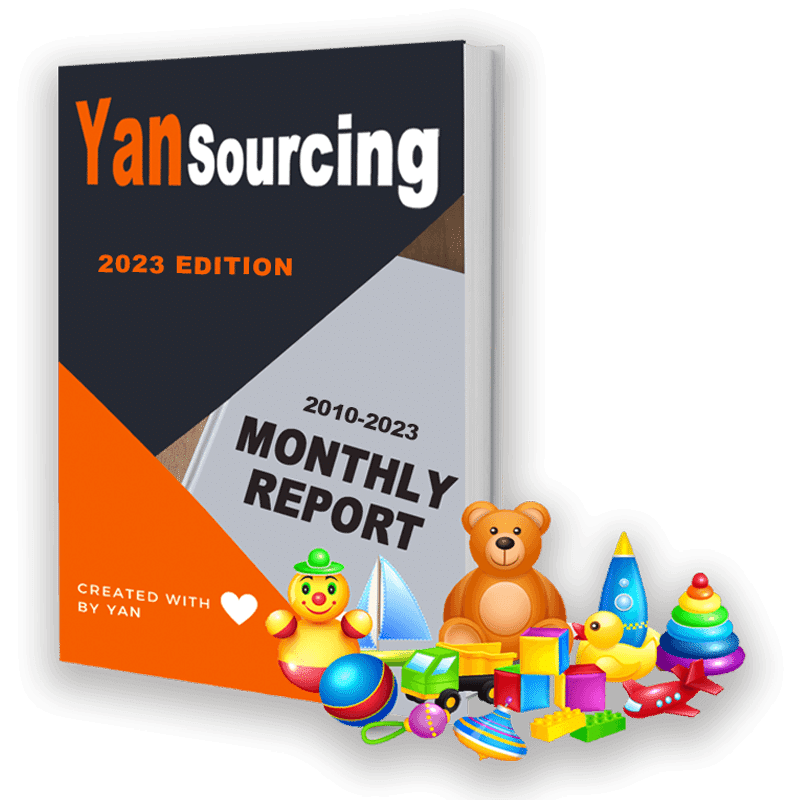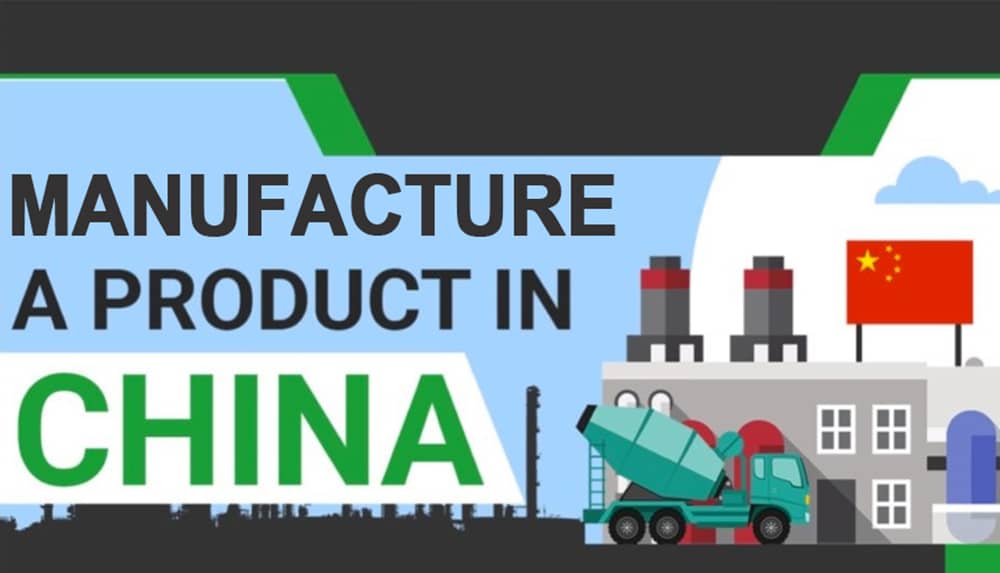
China is known as the ” World Factory” and is known for its low labor and manufacturing costs, high production capacity, and huge market expansion opportunities.
Wondering how to manufacture a product in China? If you’re not familiar with manufacturing, it can seem like a daunting prospect. It may feel out of reach.
In this guide, we’ll discuss everything you need to know about how to manufacture a product in China and provide tips to help you through each step.
Why Should I Manufacture a Product in China?
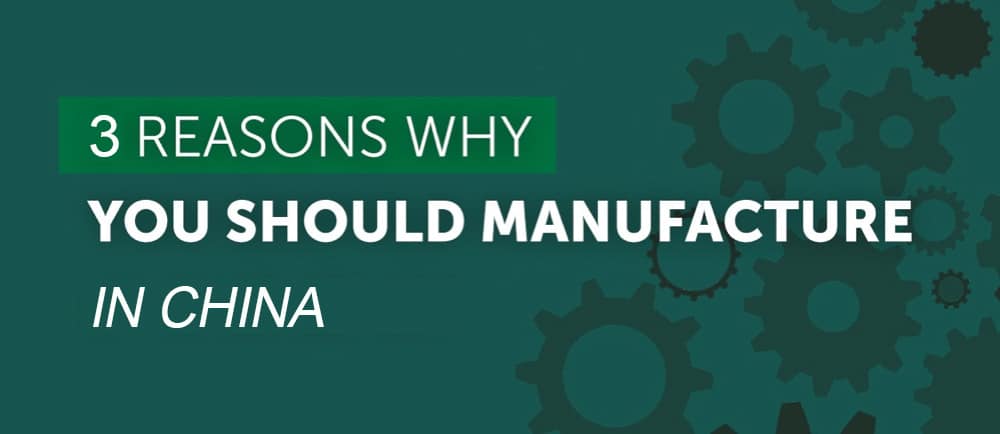
For so many years, China has been firmly established as the world’s leading manufacturing power. It is also the largest exporter of goods, far ahead of the United States.
In the past few years, many Chinese cities have become important production centers.
The following are the main reasons for manufacturing a product in China:
1. China has a highly skilled workforce
Labor costs are often a major driver for companies from more developed Western economies to outsource manufacturing in China.
Chinese labor may not be as cheap as it was a few years ago, but China’s skilled workers have maintained their competitive advantage in product manufacturing at still low prices.
2. China has stable facilities and advanced technology
While there are many other outsourcing destinations that offer cheaper labor, China’s stable facilities and advanced technology have also been the winning formula, and production costs remain relatively low.
Compared to its product manufacturing counterparts in Asia, China can handle common problems that directly affect the product manufacturing process, such as power outages and erratic supply lines.
3. China has better political stability than other countries
Political stability is another important aspect that Chinese product manufacturing companies pride themselves on. No other product manufacturing destination in Asia has as strong political stability as China.
As long as national laws and government regulations are met, product manufacturers and their partners have nothing to worry about.
How Much Does it Cost to Manufacture a Product in China?
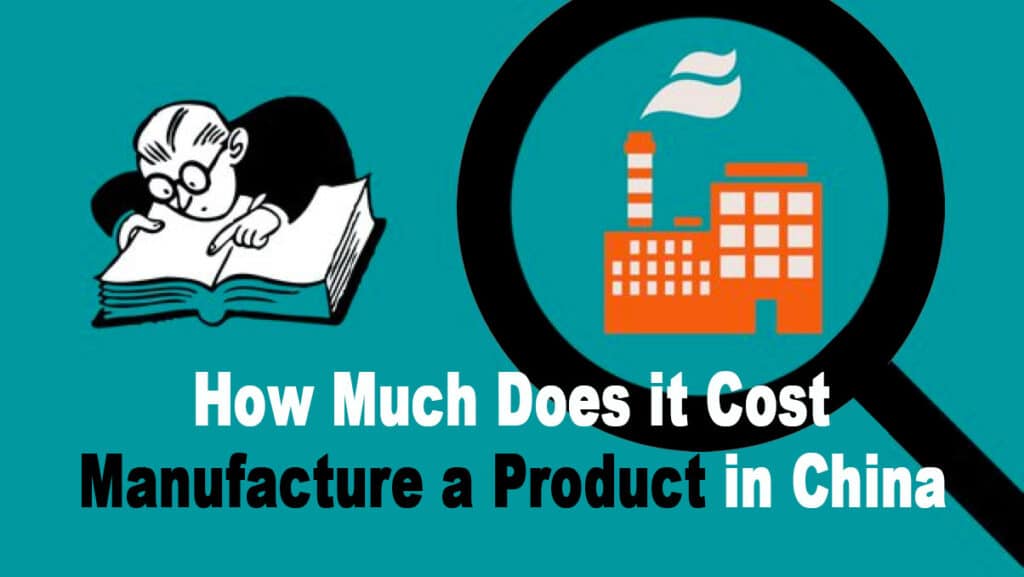
The cost of producing various products in China varies. But the bottom line is that, in most cases, production costs are cheaper in China compared to other regions.
This is due to Chinese government subsidies, preferential taxes, and economies of scale that help reduce manufacturing costs.
Here are some other contributing factors to cheap production costs in China:
- Technically automated production is usually cheaper than manual methods, and this is especially true for mass production.
- Lower labor costs in China compared to other regions. Given that manufacturing is labor-intensive, affordable labor has a significant cost advantage.
- Raw materials are readily available in China, both locally and at affordable import rates from the larger Asian region. In addition, Chinese manufacturers enjoy favorable prices for ordering such materials in bulk.
Pros and Cons of Manufacturing a Product in China
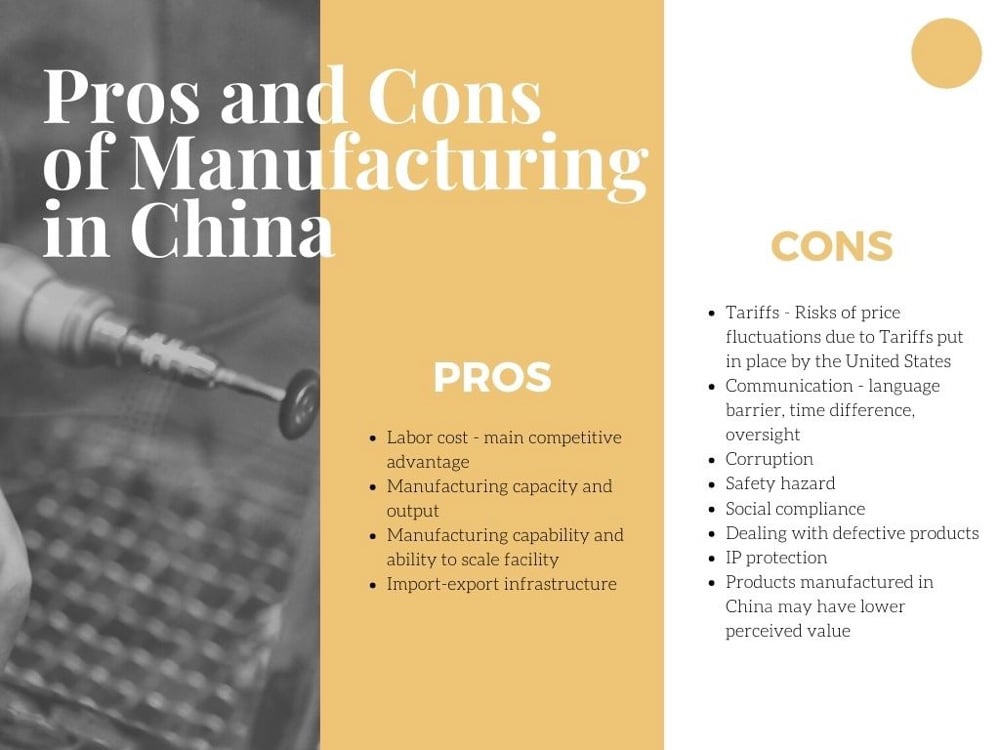
There are many pros and cons to be aware of before you start sourcing products from China. Having the right supplier is critical to the success of your business, so you need to make the right decision for your company.
Here are some of the advantages of manufacturing a product in China:
1. Lower production costs
The biggest advantage of manufacturing your products in China is that you can reduce the cost of your products without reducing the number of products you create.
This means that your profit margin may go up and you have more money to spend on other parts of your business.
2. Facilitate market expansion
By having your products made in China, you also have the potential to market your products to the local market.
This is a huge market with over 1.3 billion potential consumers and you can reap the promise of huge returns.
3. High production volume and fast turnaround
Many factories in China are known for their high production capacity and quick turnaround times, with the ability to produce large orders in a timely manner.
Cheap labor costs play a key role here. You can hire more people to complete pieces with high volume requirements.
4. Large selection of suppliers
If you choose to manufacture your product domestically, you may not have much choice in choosing a specific manufacturer.
However, in China, because there are so many manufacturers in so many different industries, you can pick the manufacturer that is right for your company.
While there are many advantages to using a Chinese manufacturing company, there are also some disadvantages to be aware of.
Here are some of the disadvantages of manufacturing a product in China:
1. Communication and language difficulties
If you do not know the language or culture, manufacturing in China will be very difficult. It is recommended that if you are not familiar with the language, you should hire an interpreter to simplify the process.
Chinese business culture is also very different from Western business culture, so it is important to keep this in mind when communicating.
2. Quality control
Creating and maintaining a quality product can be very difficult when using a Chinese manufacturer. You are not there often or at all, so you don’t really know the quality of the product.
You may get an idea from a sample, but you don’t really know until your final product is manufactured and sent.
You can use a third-party company to maintain high quality, or you can visit the factory periodically for inspections.
You may learn more about China Inspection Companies for details below:
China Inspection Service: Top 60 Inspection Companies in China
3. Intellectual property rights infringement
The risks and costs of IPR protection and enforcement in China are real. While you may understand the need to protect your IPR when selling products in China, you also need to protect yourself from manufacturers.
4. High starting order quantities
It is common for Chinese factories to have lower profit margins, resulting in higher minimum order requirements.
If your company is unable to meet these minimum requirements, you may need to look elsewhere. If you can find a factory that is willing to produce smaller orders, the unit price may go up.
What Do I Need to Know about Manufacturing a Product in China?
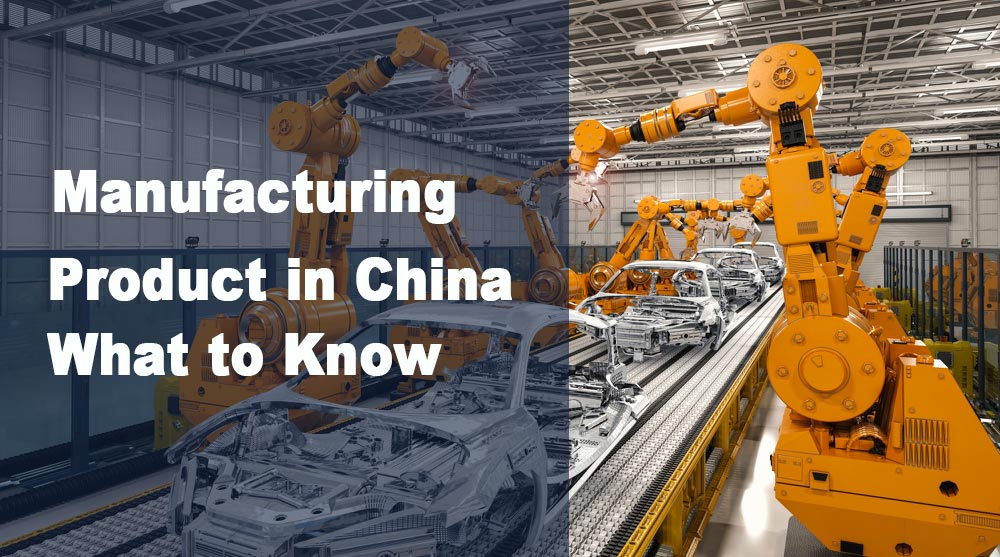
1. Understanding intermediaries
An intermediary is a term used to refer to a person who acts as a source of contact or connection between parties.
When sourcing products from China, a third party is needed to negotiate because manufacturers may lack such systems to facilitate foreign buyers.
2. Selecting a good factory
It is important to establish a good relationship with the Chinese manufacturer, as this is an important part of their culture.
The next step is to ask about their licenses, registration records, and ISO certifications, as this will confirm their validity.
3. Short lead time and low cost
Shipping costs must be considered when shipping products from China. Other costs to keep in mind are inspection costs, customs costs, and duties.
Sometimes items can also be held up at the port by customs inspectors. Make sure you have considered all of the above factors in your budget and schedule.
4. Optimized bill of materials
An optimized bill of materials helps buyers accurately estimate costs. This will help with product sourcing and product creation logistics.
Five tips that will help buyers to optimize their bill of materials are as follows:
- Enter the information related to BOM into your system as early as possible
- Don’t worry about putting the last possible little thing into the database
- Make sure your system can withstand any last-hour changes made to the data
- Don’t forget to retire assets
- Establish and maintain the integrity of the BOM. Make this part of the culture
5. Quality and test evaluation plan
Prepare a plan for testing product quality, which can be done using different technologies and software. This helps to smooth the transaction when both parties are satisfied.
The quality assurance plan outlines the written policies, procedures, and activities used to monitor and evaluate the quality of the processes required for testing.
6. Packaging, design, and review
In China, product packaging is the most visual brand description to buyers and consumers. Indeed, packaging design has less than 3 seconds to capture and hold the attention of customers and consumers.
These 3 to 5 seconds are really important because over 70% of purchase decisions are made on the shelf.
7. Document review
Documents should be reviewed after the transaction is completed to ensure that everything that was decided upon was as you wanted it to be.
The Chinese take the promises they make too seriously, so the promises that match them should be perfect and be so confident in the documentation that it is the only source of claims if something goes wrong.
How Do I Find a Manufacturer for My Product in China?
Before you start looking for a manufacturer, it is a good idea to know what you want to manufacture, the materials, the price you want to sell it for, and the quantity you want to manufacture.
If you know all of these things, you can actively search for the right manufacturer for your product.
There are several ways to find Chinese manufacturers, including:
1. Online Catalogs
This is an excellent and cost-effective startup option. These online directories can contain hundreds or thousands of manufacturer profiles. Here are some of your best options.
Alibaba
Alibaba is arguably the world’s most famous e-commerce platform and comprehensive online directory. Buyers from all over the world can reach manufacturers, traders, and wholesalers in China.
Global Sources
Global Sources is Alibaba’s biggest competitor, but it does not have trade insurance.
It does have a rating system and reviews, so you should read them carefully to make sure you find a reliable and trustworthy manufacturer.
Made-in-China
Made-in-China is another site that puts businesses in touch with Chinese manufacturers.
If your business is looking to manufacture industrial products and parts and provide inspection and reporting facilities, it is recommended that you use Made-in-China.
You may learn more about China Wholesale Websites for details below:
Complete List 2022: Top 30 Best China Wholesale Websites
2. Trade fairs
Attending trade fairs in China is a great way to gain first-hand knowledge of how things work, see real samples and talk to people face-to-face.
The Canton Fair is by far the largest and most popular trade fair in China, with almost every factory in China gathered under one roof.
Held twice a year in Guangzhou, it is divided into three phases, the first for electronics, the second for home décor, consumer goods, and gifts, and the third for apparel, footwear, textiles, and office supplies.
If you can’t spend the time and money to travel to China, don’t worry. There are also trade fairs in the U.S. that feature many Chinese people.
These trade fairs tend to be industry-specific, such as the International Consumer Electronics Show (CES) in Las Vegas, which has many Chinese participants.
You may learn more about China Trade Fairs for details below:
Complete Guide 2022: Top 5 Best China Trade Fairs
3. Search engines
When searching on Google, you need to use a variety of search terms: manufacturers, suppliers, wholesalers, wholesalers, and distributors are used interchangeably, so try different types of searches.
However, most Chinese manufacturers’ websites are not exactly up-to-date with SEO (Search Engine Optimization) and Google’s algorithm changes.
This means you will have to go deeper into the search results and go well beyond page 10.
If you are still having problems, you can make yourself aware of these search shortcuts to improve the quality of your results.
If you know someone who speaks Chinese, you can ask them to help you by searching on Baidu.
This is the Chinese version of Google, and you will often find that vendors who don’t rank on Google have a big presence on Baidu as well.
4. Trading companies
Trading companies are not factories and do not manufacture products. They are middlemen who purchase products from factories and then raise the price of the products and resell them, and usually focus on specific industries.
Companies may find it easier to work with trading companies because they typically offer easier communication (with translators), more products, and smaller MOQs.
However, there is a problem with trading companies posing as factories in China, which is why in-depth research and communication are important.
When working with an actual factory or manufacturer, you can control or negotiate prices, and delivery times and make changes to the product being created.
Trading companies usually have higher fixed prices and have no control over the production or quality of the product.
You may learn more about China Trading Companies for details below:
Complete List 2022: Top 20 Best China Trading Companies
5. Sourcing agents
Hiring a sourcing agent is a common and often successful route that many entrepreneurs choose when looking to manufacture products in China.
As a local person with local experience, a sourcing agent will guide you along the way and help you negotiate with manufacturers on your behalf.
Sourcing agents are third parties that help companies find the right manufacturer or supplier for their specific needs.
They usually have the proper practices in place to help companies find and evaluate manufacturers in terms of cost, delivery time, and quality control.
A good sourcing agent can provide the following services:
- Finding new products and reliable suppliers
- Audit existing suppliers
- Negotiate and draft contracts with the reliable suppliers
- Follow-up production and the on-time quality inspection
- Manage shipments with complete logistics
- Reduce the risk of product sourcing in China
- Extra customization services
- Offering private-label solutions
You may learn more about China Sourcing Agents for details below:
Complete List 2022: Top 100 Best Sourcing Agent in China
12 Steps on How to Manufacture a Product in China
Manufacturing your products in China can be confusing and stressful. We hope the following distribution guidelines will help you get started with manufacturing in China.
Step 1. Create an idea
Before you start trying to create your idea, there are three main things you need to know:
- Create a completely new product or improve on an existing product
- Most manufacturers require a minimum order quantity
- Each product you create will usually need to meet the minimum requirements for custom manufacturing
Step 2. Design or sketch the product idea
You cannot begin the manufacturing process until you create a design or sketch of your product. No one can see what’s in your head. You must give them something to help them understand what you need.
Step 3. Find a product development consultant
Once you have an idea and a drawing, you may need to find someone who knows how to make the product and has done it many times before. They can help you reduce the time it takes to complete the rest of the steps.
Step 4. Create a prototype
Creating a prototype to showcase your target market, as well as potential manufacturing partners, is necessary to limit risk and increase your chances of success.
Step 5. Test the prototype
After creating a prototype, you need to verify that it works and that there is a real need for it. After testing, start conducting market research.
Market research can be as simple as having friends and family test it or using a market research firm to conduct a formal study.
Step 6. Find a manufacturer to build your product
Communication, certification, pricing, and timeliness are key factors to consider when deciding on a supplier. There are many resources available to help you find the right manufacturing match for your product.
For example trade fairs, Alibaba, sourcing agents, and trading companies are all legitimate options, depending on your needs and budget.
Step 7. Compare manufacturing costs
You’ve found a number of different potential suppliers and manufacturers, visited them, and gotten quotes.
Now it’s time to compare them. Remember that whichever manufacturer or intermediary you decide to choose, don’t sacrifice product quality.
Step 8. Custom samples
After carefully checking and identifying the right manufacturer, you can start the pre-production sample process, which is a key reference for checking samples and quality.
Step 9. Sign a manufacturing contract
When you negotiate a manufacturing contract, the goal is to establish a mutually beneficial long-term relationship.
We strongly recommend that you consult with an experienced contract attorney before negotiating the terms of your manufacturing contract.
Step 10. Start manufacturing
This phase will be handled by the manufacturer. If you are personally monitoring compliance with the contract, periodic checks will be required to verify that specifications are being met and that the schedule can still be achieved.
Step 11. Quality control
It is necessary to check product quality throughout the critical stages of production. There are many third-party quality inspection companies in China (such as Insight) that can perform pre-shipment inspections for you.
Step 12. Manage logistics
Although shipping is not a direct part of the manufacturing process, you must still coordinate with the manufacturer.
Find a manufacturer who can ship to your sales market or who can coordinate shipping with a trusted shipping service provider.
Manufacturing a Product in China FAQ
1. How to calculate the full cost of manufacturing a product in China?
Do your research. Contact manufacturers of similar products and consumers who already buy similar products from China. Pay close attention to all parameters that affect the cost of the product.
2. Why does google have little information about Chinese manufacturers?
Chinese manufacturers and companies rarely create online media accounts or produce ads online for their promotions. There are more manufacturers on Alibaba than on the web.
3. Should I visit my manufacturer in China?
Visiting manufacturers is time-consuming and expensive because it requires a lot of work, time, effort, and preparation to visit manufacturers in person. In addition, the distance between suppliers may not be beneficial for everyone.
Manufacturing a Product in China Conclusion
To understand “how to manufacture a product in China“, it is necessary to conduct thorough research of the products available on the market and then determine the most suitable manufacturer for them and their products. It’s actually to your advantage, depending on what’s on your list.
We are the leading sourcing company in China and are committed to helping our customers source good products from China at the most competitive prices. If you want to import from China, please feel free to contact us.


